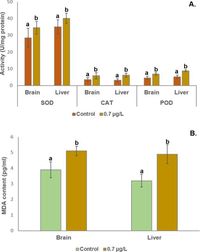A new study sheds light on the detrimental effects of cypermethrin (CYP), a widely used pesticide, on Labeo catla, an important fish species in aquaculture. Researchers from India conducted an in-depth analysis using RNA-sequencing to assess the brain and liver transcriptomes of L. catla exposed to long-term, low-level CYP concentrations.
Cypermethrin, classified as a synthetic pyrethroid, is utilized heavily in agriculture due to its efficiency in pest control and relatively low toxicity to mammals and birds. However, its widespread application raises concerns regarding the unintentional exposure of non-target species, particularly aquatic organisms. In their paper, published on March 19, 2025, the researchers reveal that long-term exposure to CYP can lead to significant alterations in gene expression in the fish, impacting its physiological health and environmental integrity.
In the study, L. catla were subjected to 0.7 µg/L of CYP, a dose regarded as low but still impactful. The authors identified over 26,000 unigenes in the brain and around 18,000 in the liver tissues. More specifically, they discovered 333 differentially expressed genes (DEGs) in brain samples and 454 DEGs in the liver following the CYP exposure. "Our findings provided significant insights into the consequences of CYP-induced toxicity in fish," wrote the authors of the article.
The toxicity mechanisms relating to CYP were observed through various biological pathways linked to health problems, including the MAPK signaling pathway and apoptosis pathways, both of which were co-expressed in the brain and liver transcriptomes of L. catla. Notably, genes associated with steroid and terpenoid backbone biosynthesis were found to be overexpressed in the liver, suggesting potential induction of apoptosis as well as steroid production. These changes can impact the hormones and developmental processes essential for fish health.
Additionally, the study highlighted alterations in levels of various antioxidant enzymes in L. catla exposed to CYP. Specifically, the activities of superoxide dismutase (SOD), catalase (CAT), and peroxidase (POD) were significantly increased, while malondialdehyde (MDA) content increased as well. These indicators reflect heightened oxidative stress in response to chronic exposure to the pesticide.
From a methodological standpoint, the study used rigorous protocols for transcriptomic analysis, showing how chronic exposure to environmental pollutants like CYP can be effectively monitored through RNA-sequencing. "This approach could also help identify adverse outcome pathways for future studies to understand the potential interactions of CYP with the brain and liver of fish," the authors stated.
The researchers emphasized that L. catla is not only economically important but also serves as a potential bioindicator for assessing ecological risks posed by pesticides in aquatic environments. By detailing the transcriptomic alterations that result from pesticide exposure, the study underlines the challenges faced by fish and other aquatic life due to agricultural runoff and contaminants in waterways.
In summary, this investigation provides critical data that point to the molecular effects of cypermethrin exposure on Labeo catla and establishes a foundation for future ecotoxicological assessments. As the usage of cypermethrin and similar pesticides continues to rise globally, understanding their long-term impacts on non-target aquatic species is imperative for both environmental management and food safety strategies.




